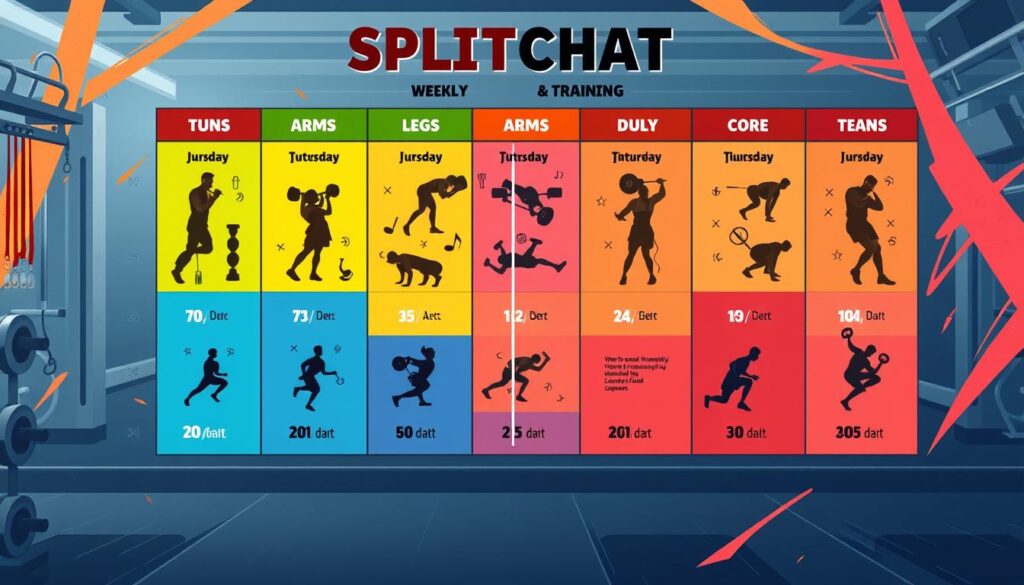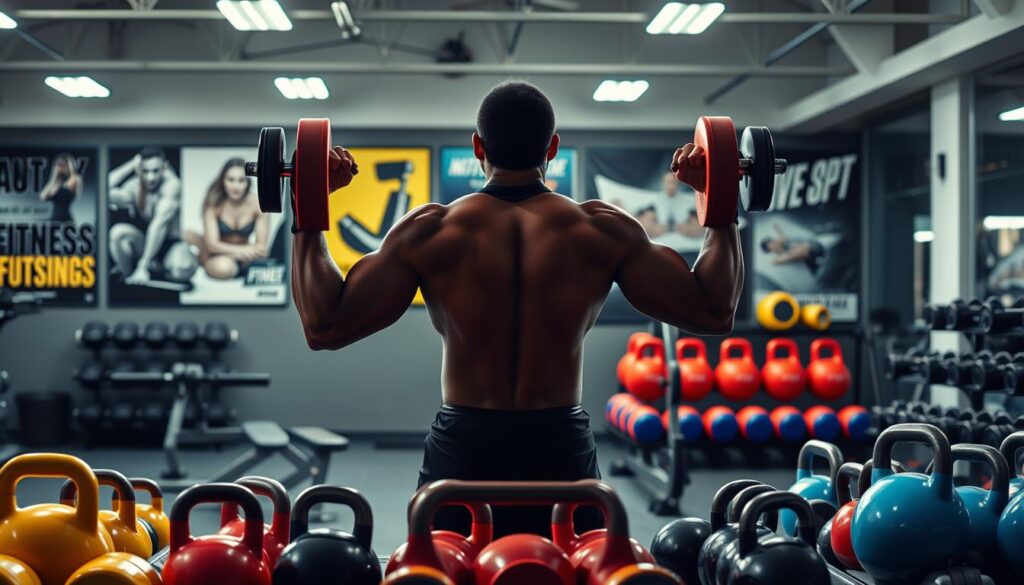Many people want a lean, sculpted body. But getting there is hard. Yet, you can lose fat and build muscle at the same time. This is called body recomposition.
It works by focusing on strength training and eating right. This helps your body burn fat and grow muscle.
Understanding how to lose fat and gain muscle is key. When you build muscle, your body burns more calories. This is because it needs more energy to keep the muscle.
Eating a lot of protein and using supplements helps too. It makes your body ready to lose fat and build muscle.
Key Takeaways
- Body recomposition involves losing fat and gaining muscle simultaneously, a challenging but achievable goal.
- Prioritizing muscle building through resistance training can trigger increased metabolism and fat loss as a byproduct.
- A high-protein diet and strategic supplementation are essential for supporting muscle growth and fat loss.
- Compound exercises that engage multiple muscle groups are effective for building strength and burning calories.
- Incorporating a balanced approach of resistance training, interval cardio, and rest and recovery is key for optimal results.
Understanding Body Recomposition: The Science Behind Fat Loss and Muscle Gain
Body recomposition is about losing fat and gaining muscle at the same time. It needs good food and exercise to change your body slowly. Knowing how it works is important for your body transformation goals.
What Happens in Your Body During Recomposition
Your body changes a lot during body recomposition. It burns fat for energy and builds muscle with exercise. This balance is what makes your body change.
The Role of Metabolism in Body Transformation
Your metabolism is very important in body recomposition. More muscle means you burn more calories, even when you’re not moving. Also, eating the right foods at the right time helps you lose fat and gain muscle better.
Breaking Down the Fat Loss Process
To lose fat well, you need to eat a bit less but still eat enough protein. Eating 0.64-1.4 grams of protein per pound of body weight helps keep muscle while losing fat. Exercise and eating at the right times help even more.
“Increasing muscle mass can boost resting metabolic rate (RMR), leading to burning more calories while at rest.”
Body recomposition takes time and effort, and results can differ. But with the right nutrition and training, you can lose fat and gain muscle. This will change your body and improve your health and happiness.
Why Traditional Cardio Isn’t the Ultimate Solution
Many think endless cardio is key for a dream body. But new research shows this might not be true. Too much traditional cardio could actually slow down your progress.
Cardio doesn’t help build muscle well. Muscle burns more calories than fat. So, doing resistance training boosts your fat-burning ability, even when you’re not moving.
High-intensity interval training (HIIT) is better for fat loss than steady cardio. HIIT involves short, intense workouts followed by rest. It raises growth hormone and burns fat better than long cardio sessions.
| Cardio Type | Fat Burning Potential | Muscle Building Impact |
|---|---|---|
| HIIT | High | Moderate |
| Steady-State Cardio | Moderate | Low |
| Resistance Training | High | High |
Cardio is good for heart health and some fat loss. But for lasting fat loss and body change, you need a balanced plan. This includes resistance training, smart calorie control, and some cardio. This balanced approach helps you reach your fitness goals.
“The key to long-term fat loss and body recomposition is not just about the number of calories burned during exercise, but rather the lasting impact on your metabolism and body composition.”
Burn Fat Weight Lifting: Core Principles and Benefits
Forget about traditional cardio – weight lifting is the key to unlocking your true fat-burning potential. By understanding the core principles and benefits of resistance training, you can transform your body composition and achieve the lean, sculpted physique you’ve always wanted.
Metabolic Advantages of Weight Training
When you lift weights, your muscles are put under tension. This leads to micro-tears that your body then repairs by creating more muscle fibers. This process not only builds lean muscle mass but also burns a significant number of calories, even long after your workout is over.
Hormonal Benefits of Resistance Training
Weight lifting stimulates the release of growth hormone and testosterone. These two powerful hormones play a critical role in fat loss and muscle gain. By tapping into these hormonal advantages, you can maximize your body’s natural ability to shed fat and build the physique of your dreams.
Long-term Impact on Body Composition
Consistent weight training not only transforms your body in the short-term but also has long-lasting effects on your overall body composition. As you build more muscle, your metabolism will increase. This allows you to burn more calories throughout the day, even at rest.
Embrace the power of weight lifting and watch as your body undergoes a profound transformation. By following the core principles and harnessing the benefits of resistance training, you’ll be well on your way to achieving the weight lifting for fat loss, lifting weights to burn fat, and resistance training benefits you’ve been seeking.
“Strength training is one of the most effective ways to transform your body composition and achieve sustainable fat loss.”
Creating Your Optimal Training Split
There’s no single workout split for everyone. You need to find a training program that fits your goals and fitness level. By planning your resistance training routine well, you can lose fat and build muscle.
One good way is the body part split. You split your workouts by muscle group, training each 1-2 times a week. This helps your muscles recover and grow. Another choice is the upper/lower split, switching between upper and lower body exercises.
- Body part split: Train each muscle group 1-2 times per week
- Upper/lower split: Alternate upper body and lower body workouts
- Push/pull split: Separate pushing and pulling movements
- Full body split: Train all major muscle groups in each workout
Research shows a simple 2-day full body routine can be as good as a complex 4-6 day split. The important thing is to rest for at least 48 hours between workouts for the same muscles.
The best workout split is one you can keep up with and meets your fitness goals. Try different methods and find what works for you.

“The secret to achieving your fitness goals is finding a training program you enjoy and can sustain over the long term.”
Essential Compound Movements for Maximum Results
Compound exercises are key for strength training and muscle building workouts. They work many muscles at once. This leads to more calorie burn, muscle growth, and better body shape. Let’s look at the top compound exercises for a better fitness journey.
Upper Body Power Exercises
Movements like the Incline Bench Press, Barbell Pulldowns, and Standing Overhead Press work the chest, back, and shoulders. These compound exercises boost upper body strength and help burn fat.
Lower Body Strength Movements
The Barbell Back Squat, Deadlift, and Dumbbell Lunges are great for lower body strength and muscle mass. They work the glutes, quadriceps, and hamstrings. This changes your body shape and increases strength.
Core-Strengthening Exercises
Movements like the Decline Sit-Up and Cable Wood Chops focus on the core. They improve posture, balance, and stability. Adding these to your routine helps with fat loss and muscle building.
Adding these compound exercises to your workouts is a smart move. They work many muscles at once. This means faster fat loss and muscle growth, leading to a better body shape.
Nutrition Strategies for Body Transformation
Getting the body you want takes more than just working out hard. You also need a smart diet plan. If you want to lose fat or gain muscle, eating right is key for body recomposition.
For the best results, eat a balanced diet with lots of protein. Aim for 30-35% of your calories to come from carbs, 30-35% from protein, and 30-40% from fats. Carbs help your muscles grow, thanks to your workouts.
Try intermittent carb refeed days to beat weight-loss stalls. This trick can really help your body burn fat faster.
For healthy fat loss, cut about 500 calories a day (3,500 a week). But don’t cut too many calories. It can cause you to lose weight too fast, which is hard to keep up.
Eat lots of whole foods and watch your macronutrients. This helps you lose fat and build muscle at the same time. Keep an eye on how you’re doing and change your diet if needed. This will help you reach your body goals.
Protein Requirements and Muscle Protection
Protein is key for changing your body and losing fat while keeping muscle. You need enough protein to keep your muscles strong when you eat fewer calories. Try to eat at least 1 gram of protein for every pound of your body weight.
Optimal Protein Timing
It’s important to eat protein at the right times for muscle growth and repair. Eat protein all day, but especially after working out. This helps your muscles use the protein to heal and grow.
Best Protein Sources for Fat Loss
- Lean animal proteins like chicken, turkey, and pork
- Fish and seafood, which are rich in omega-3 fatty acids
- Dairy products such as Greek yogurt and low-fat cheese
- Eggs, which provide a complete amino acid profile
- Plant-based proteins like tofu, tempeh, and legumes
- Protein supplements like whey, casein, or plant-based powders (if needed)
Eating these high-protein foods helps keep your muscles strong while you’re losing weight. This makes sure your body looks good when you’re done.
| Protein Source | Protein Content (per 100g) |
|---|---|
| Chicken Breast | 31g |
| Salmon | 25g |
| Greek Yogurt | 10g |
| Eggs | 13g |
| Tofu | 8g |
Eating these high-protein foods and timing your protein right helps protect your muscles. This fuels your body’s change.
Strategic Calorie Cycling for Fat Loss
If you want to lose fat and keep your muscles, try calorie cycling. This method means eating fewer calories on some days and more on others. It helps your body lose fat and keep muscle.
On low-calorie days, eat about 1,990 calories. This is a bit less than what you need each day. On high-calorie days, eat more carbs and less fat. Keep your protein the same. This way, you keep your metabolism up and lose fat.
| Day | Calories | Carbs | Protein | Fat |
|---|---|---|---|---|
| Lower-Calorie Day | 1,990 | 40% | 30% | 30% |
| Higher-Calorie Refeed Day | 3,000 | 50% | 30% | 20% |
By changing your calorie intake, you can lose about 1 pound a week. This is good for athletes and people with some body fat. It keeps your energy up and helps you lose fat.
Calorie cycling works differently for everyone. Your needs and how active you are matter. Talk to a nutrition expert to make a plan that fits you.

Recovery and Rest: Keys to Transformation Success
To reach your body goals, rest and recovery are as key as working out and eating right. Good sleep helps your body fix muscles and balance hormones. A 2020 study showed that not sleeping well lowers muscle-building helpers in your body.
Also, using low-intensity cardio helps avoid burnout and keeps your heart healthy. Finding the right mix of hard workouts, rest, and easy cardio helps you lose fat and grow muscles.
Sleep Quality and Hormonal Balance
Sleep is when your body fixes and grows. Getting 7-9 hours a night helps your body make important hormones. These hormones help your muscles grow and recover. By making sleep a priority, you help your body get stronger and look the way you want.
Active Recovery Methods
While hard workouts are great for muscles and fat loss, you also need easy recovery. LISS cardio, like walking fast or jogging lightly, keeps your heart healthy and burns calories. It also stops you from getting too tired or hurting your muscles. Switching between hard workouts and easy cardio keeps your body balanced and helps you reach your goals.


A Life-Changing Experience with This Weight Loss Supplement (Nagano Tonic)
I’ve always struggled with finding a weight loss solution that actually works for me. Like many, I’ve tried numerous diets, exercise routines, and supplements over the years—some worked for a short time, but nothing ever gave me long-term results. That was until I decided to try the weight loss supplement I found : Link to the Supplement.
From the moment I started using it, I noticed a difference. Not only did I feel more energized, but my cravings also became more manageable. The best part? I started seeing results much quicker than I anticipated! Over the course of just a few weeks, I noticed a significant reduction in belly fat and overall weight loss that I hadn’t been able to achieve before.
What makes this supplement stand out from all the others I’ve tried is how it supports me in my daily routine without any jitters or energy crashes. I’m able to stay focused and motivated, which has made it easier to stay on track with my diet and exercise plan.
This product truly exceeded my expectations, and I feel more confident and healthier than ever before. If you’re struggling with your weight loss journey like I was, I highly recommend giving this supplement a try. It’s been a game-changer for me, and I’m sure it can work wonders for you too!
Contant Them on email .. tonicnagano50@gmail.com